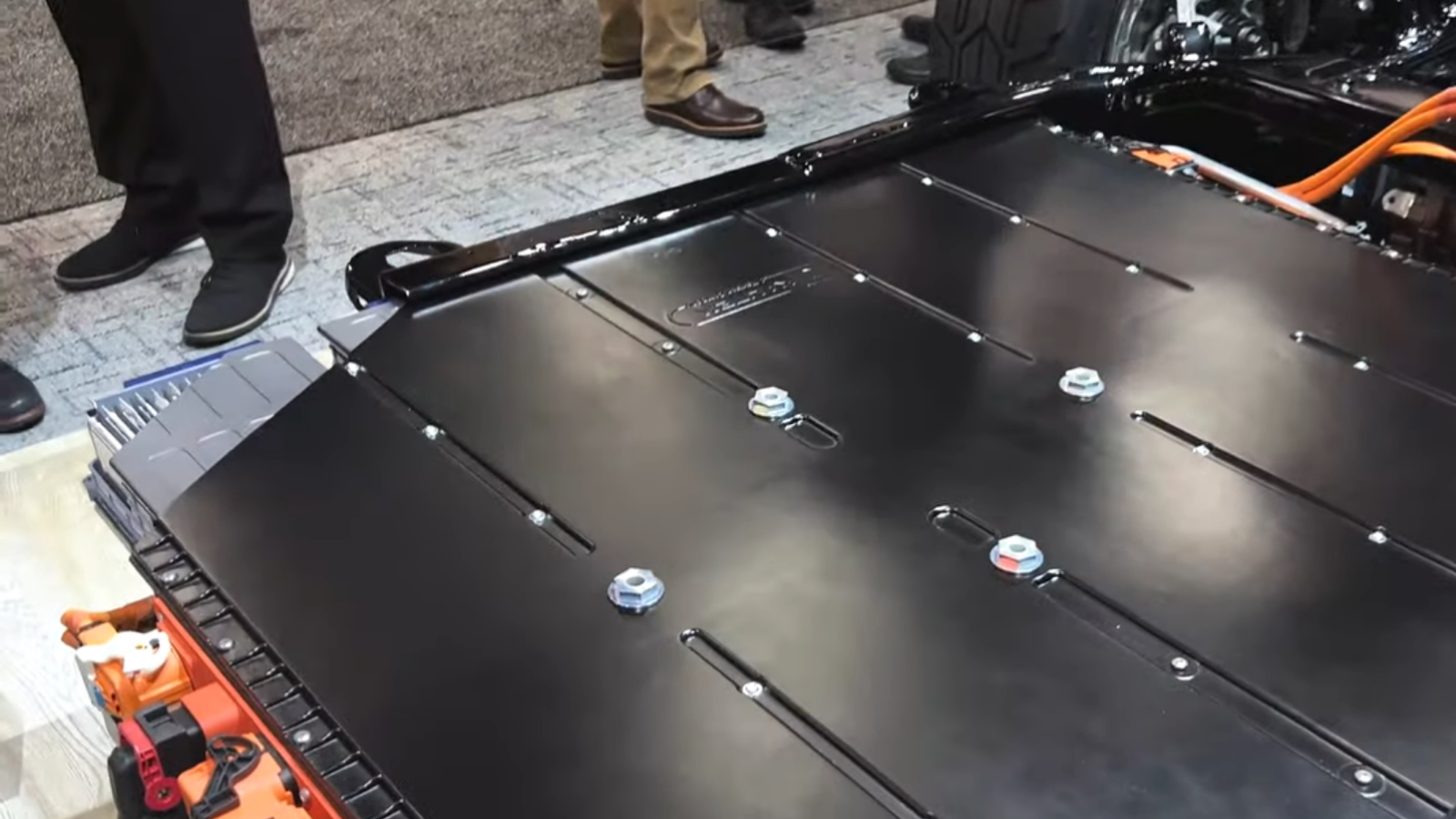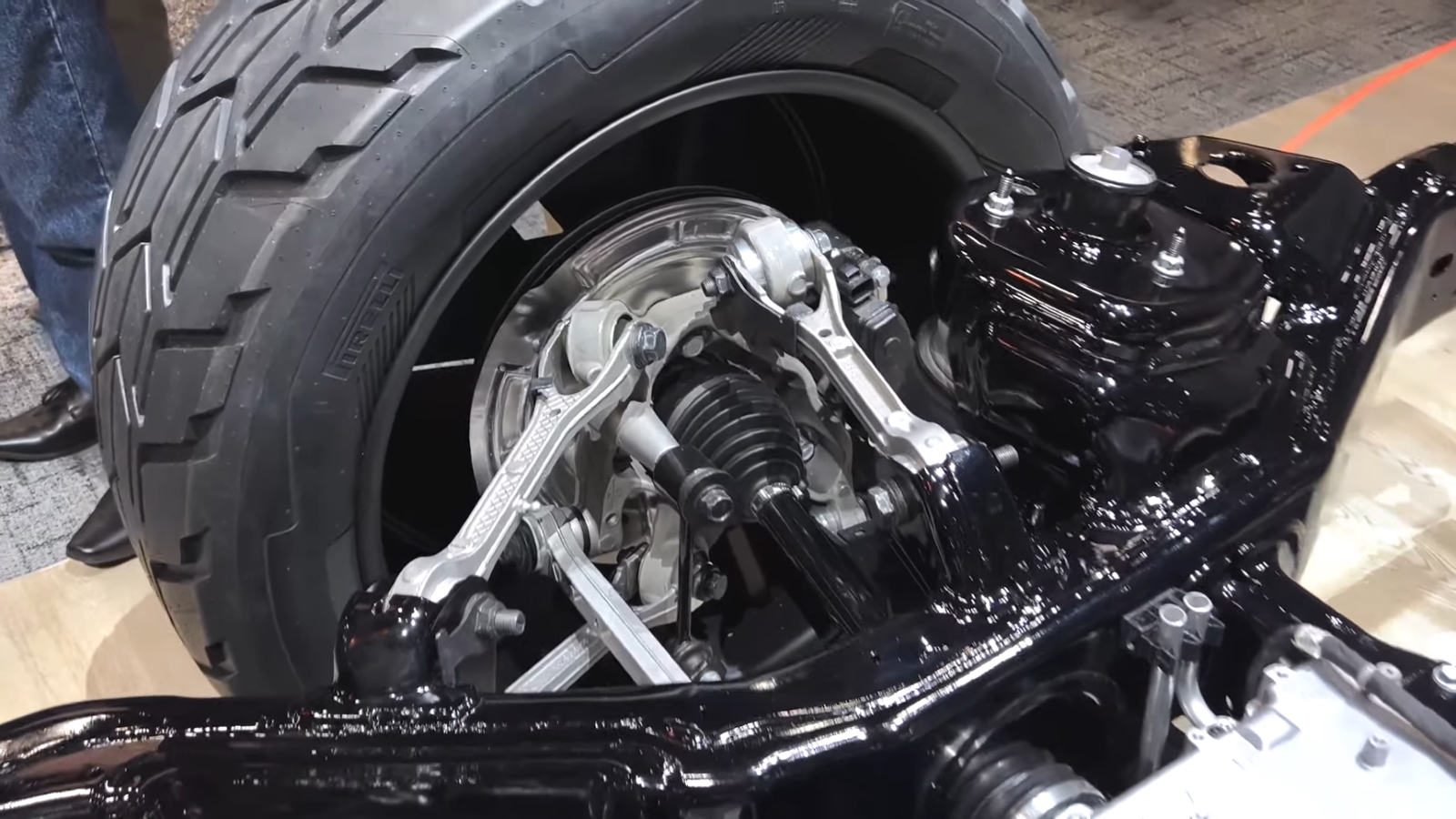First, a primer on exactly what STLA Frame is. At the core of Stellantis’ big electric push are four EV platforms called STLA Small, STLA Medium, STLA Large, and STLA Frame. Yes, STLA is pronounced ‘Stella.’ STLA Medium and STLA Large are expected to launch this year, although it’s tough to say what will ride on them first. Will the Jeep Wagoneer S or the upcoming Dodge Charger replacement run on STLA Large first? What sort of Peugeot, Opel, Alfa Romeo, and DS products will ride on STLA Medium? At this point, only Stellantis knows.
However, we know for sure that the upcoming electric Ram pickup truck will use the STLA Frame platform, and Stellantis has given everyone an early glimpse by rolling out a prototype frame of sorts at CES. Our friends at engineering firm Munro & Associates managed to capture this display on video, so we’re able to dive in and have a gander.
Let’s start with the frame itself. Unsurprisingly, it’s a fully-boxed fth, as is typical for full-size pickup trucks these days. However, like on the Rivian R1T, the frame appears largely open between the rails to allow space for a battery pack. This likely means that the battery pack plays a structural role, absorbing crash energy in the event of a side-impact collision.
Moving up front, let’s take a look at the front drive unit. Sandy Munro thinks that Stellantis might retain this motor for the inevitable production model, which isn’t a bad bet to make. It’s certainly a beefy unit, but it’s packaged nice and low in the frame in a way that should benefit frunk space. Stellantis was able to make this happen by putting the motor right behind a major crossmember. Smart packaging.
In the model, it looks like the inverter sits right behind the front motor, ahead of where the battery pack should go. Of course, this could change for production, but mounting the inverter right next to the battery pack’s high-voltage terminals seems cromulent. Speaking of the battery pack, STLA Frame will accommodate some huge battery pack sizes, as Stellantis is targeting up to 500 miles of range on this platform. Expect a minimum capacity of 159 kWh with a maximum of over 200 kWh.
Moving along, let’s check out the rear drive unit. It appears different to the front motor, indicating that the electric Ram 1500 could potentially feature a more powerful rear drive unit for rear-biased all-wheel-drive. Putting EV-specific stuff aside, let’s talk rear suspension, which is traditionally a live axle on combustion-powered pickup trucks. Of course, hooking an electric motor up to a live axle presents all sorts of unsprung weight and packaging challenges, so automakers are moving to independent rear suspension. Ford decided to use massive massive trailing arms on the F-150 Lightning, but Stellantis is taking a more delicate approach. What we’re looking at here is a five-link rear suspension setup that should be generally familiar in concept to BMW 3-Series owners.
In this case, we have a thrust arm, a semi-trailing arm, an upper control arm, a camber arm, and a track link all working together in harmony. All but the camber arm are aluminum parts, and the track link sits ahead of the CV axle. While this setup will likely pay dividends in ride quality, five-link upkeep can get expensive as bushings start to wear out.
It’s also worth noting that this example of STLA Frame uses air suspension which appears to employ a spring-over-damper design. It’s a space-efficient setup that’s a departure from the divorced spring and damper setup Ram is currently using in light-duty trucks, but Ram’s experience with air suspension should play to its advantage. Overall, there’s lots to like about Stellantis’ STLA Frame architecture. From the multi-link rear suspension to the smart front motor packaging, Ram’s future bones look promising. Expect to see STLA Frame underneath electric pickup trucks in 2024 when we get a glimpse at a production-spec Ram EV. (Photo credits: Ram, Munro Live)
The Ram 1500 Revolution Is A Three-Row EV Wondertruck For The Future
Here’s What Our Professional Car Designer Thinks Of The Ram 1500 Revolution
What Do You Think About The Upcoming All-Electric Jeep Wagoneer S?
The Dodge Charger Daytona SRT EV Concept Looks Surprisingly Production-Like
The 2022 Ford Lightning Is Just A Standard F-150 With An Electric Powertrain And That’s Why It’s Going To Change The World
I’m fortunate enough to have a small car right now I can commute in, but it wasn’t long ago that I had one vehicle. And if you need to tow/haul, that one vehicle is going to be a truck. Even if you only need it on the weekend.
It’s even arguable that having a second vehicle might be worse than driving said truck to work, from a total pollution standpoint, depending on your commute.
All of that to really say : that rear suspension sure doesn’t look up to the type of abuse these 2/3/400k mile pickups I see all the time go through. Love the ride benefit, hate the repairs I see in the future. Possibly wrong application for that rear suspension.
This is not the way.
I like the bumper seats and overall engineering, but the aluminum multilink suspension looks a bit fragile for something that ostensibly should go off-road. Perhaps someone with more off-road experience can correct me.
I know that EV pickups are important, because the math checks out. By my numbers, a gasoline crossover switching to an EV equivalent saves around 8,000 lb of CO2 per year. For a pickup, it’s about 15,000 lb of CO2 per year. Obviously, it would be better if people who didn’t need pickups switched to something smaller, but that’s a dead-end conversation.
The thing that bugs me is, I know most people aren’t using their pickups professionally/seriously. They never take their trucks offroad (grass parking lots don’t count) and never haul anything with them (that they couldn’t just as easily cram in a hatchback). Making an EV pickup that’s unsuitable or inconvenient for these tasks — and then successfully selling it — just proves most buyers truly didn’t need these capabilities. It throws into stark relief how BAD the farce really is.
Like, you’re getting an EV pickup that’s heavier than any passenger vehicle has any right to be, whose bulk and mass is credited with road damage, skyrocketing pedestrian and cyclist fatalities, and the ongoing arms race in crash safety that’s making small sustainable cars impossible.
And for what? A costume. The automotive equivalent of a desk jockey wearing a cowboy hat and boots.
Bah, don’t listen to me. This rant isn’t going to solve anything.
The same can be said about any luxury car and any sports car.
Buying a vehicle is not about needs most of the time.
If it was, then cars like the Yaris, Mitsu Mirage, Fit and others would be top sellers and pickup trucks would mostly be owned by companies for actual work. And pickup trucks wouldn’t have luxury interiors.
With the recent snowstorms in my area I’ve found for the first time ever my pickup truck is low on ground clearance, and it made me greatly appreciate height adjustable air suspension setups like what the LR3 & LR4 have. I’m normally a huge fan of solid axles but without putting bigger wheels on your solid axle/s drivetrain clearance stays the same. With height adjustable air suspension your diff has even more ground clearance than normal.
Honestly I’m no longer considering getting a Mini BEV or a Fiat 500e, they don’t have enough ground clearance and their lack of AWD keeps them from plowing through the soft snow with their front bumper either. The only BEV that is supposed to be sold in the US in the near future that I actually want is the Cybertruck and that’s because it would be a mostly problem free BEV with an amazing trouble free charging network, ultra durable body with no paint I have to worry about getting scratched, AND IT’S SUPPOSED TO COME WITH HEIGHT ADJUSTABLE AIR SUSPENSION!
Sorry Tesla but I don’t want a Model X, maybe if it came with van doors I’d get one but I won’t get one with those stupid wing doors.
If Ford came out with a height adjustable air suspension option for the F-150 Lightning along with a 3 seat front row option (like the ICE F-150) and a single cab option I’d almost certainly get one of those, but whoever is first to market will get my money, I’m not buying any mass production new car made after 2026.
Tell that to Doc Brown.
This is one of the immovable objects that the rest of the vehicle gets designed around. You can move it in X and Z maybe an inch before your CV joints become less durable.
Sadly, I don’t know when someone will offer that.
The F150 Plugin Hybrid comes pretty close to that actually, but needs about 3 times as much range as the one currently in them. The current 10 miles is just sad, and seems more like a gimmick than an actually usable plugin. Hopefully someone figures it out in the next couple years, as I’d like to have the option in my next truck.
I’m with you on these things, and I would really like to not need a vehicle.
For people who actually use the “truck” part of pickups? BEV has no future. Not in my lifetime, not in your lifetime. The only way to ‘fix’ it is to either magically reduce the battery weight by 50% while increasing capacity 25% (hahaha NOPE,) or to play the idiot’s game of ‘make more range by adding more batteries that add more weight necessitating more batteries to offset that weight which increases the weight so add more batteries…’ Which is the Hummer EV. With the most advanced battery technology available not only today but foreseeable in the next 5 to 10 years, a pickup that could pull a 7500lbs trailer 400 miles without charging would end up with a curb weight somewhere around 17,000lbs.
But somewhere around 60% or 70% of pickup truck buyers don’t ever haul anything more than a few bags of mulch in their entire ownership period. THAT’S who these are actually built for.
They will eventually. But as you said, they are the minority of truck buyers.
And over the past decade, battery tech has effectively gotten a lot lighter and with better range. Just compare the 2012 Model S to a new one. The weight increase over the original is mainly due to the additional motor. The battery pack weighs the same or is a bit lighter… and it has around 50% more range over the longest range model you could buy in 2012.
They can also be used as rentals where they should get daily, rather than a couple times a year use.
If we could get 80% of the fleet converted, it would go a long way towards fixing things.
Problem is that nobody is willing to accept a practical solution over a final one.







